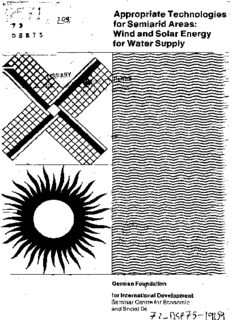
Appropriate Technologies for Semiarid Areas: Wind and Solar Energy for Water Supply (1975) PDF
Preview Appropriate Technologies for Semiarid Areas: Wind and Solar Energy for Water Supply (1975)
?••'" t"' Appropriate Technologies 103} for Semiarid Areas: 7 I Wind and Solar Energy D S E 7 5 for Water Supply German Foundation f for International Development Seminar Centre for Economic and Social De LI8R* BY 9 ^ inr.f.-ii^A-.al Refer-,::.5 Centre "*" for Community W;v/jr Supply INTERNATIONAL CONFERENCE APPROPRIATE TECHNOLOGIES FOR SEHIARID AREAS: WIND AND SOLAR ENERGY FOR WATER SUPPLY 15 to 20 September 1975 Berlin (West) CONFERENCE REPORT GERMAN FOUNDATION FOR INTERNATIONAL DEVELOPMENT Seminar Centre for Economic and Social Development in FOREWORD The drastic rise in oil prices in recent years has lent renewed impetus to worldwide efforts to develop alternative sources of energy. New, alternative and low-cost energy sources have become vital for the economic survival of many developing countries, in particular those which possess few raw materials and have no income to pay vastly increased energy bills. Drought disasters in the countries 1n the semiarid areas which have led to the mass death of humans and cattle have focussed attention on the connection between attempts to Improve the water supply of these regions and the lack of appropriate technologies and energy needed to operate these technologies. The Seminar Centre for Economic and Social Development of the German Foundation for International Development has tackled the problem of appropriate technologies 1n a whole series of events and has already published discussion material on this subject reflecting the view of African countries. The purpose of the Conference on Wind and Solar Energy for Water Supply In Semiarid Areas was to offer a further forum for discussing the present state and development potential of non-conventional technologies, adapted to the natural conditions and acute needs of the developing countries. The experts from both developing and Industrial countries who were approached In connection with the Conference demonstrated a lively Interest 1n the topic. Their contributions showed that there are already a number of well-tested and also newly developed methods for using wind and solar energy for water supply which, once they have reached the stage of mass production, will be able to contribute significantly to solving energy and water problems in the semiarid areas. 1v This Report is intended to make available the Conference material and discussion results to all Interested persons in the research, economic, and political sectors and hence to provide impetus for the further development and practical application of these technologies. The German Foundation for International Development wishes to express Its gratitude to all the authors and Conference participants for having contributed to the success of the Conference and the preparation of this Report. Brigitte Freyh " Dr Gerhard Fritz Director General Director General CONTENTS Page RESOLUTION 1 I. CONDITIONS AND CONSTRAINTS FOR WIND AND SOLAR 3 ENERGY IN WATER SUPPLY 1. Some Remarks on the Use of Wind and Solar 5 Energy In Sewiarid Areas H. Tabor 2. Approaches to Water Pumping 1n Arid and 11 / Semiarid Lands S. B. Watt 3. Discussions and Recommendations 37 II. WIND ENERGY 41 1. Efficiency and Economic Comparison of 43 Different WEC - (Wind Energy Converter) Rotor Systems H. Dbrner 2. Flapping-vane Wind Machine and Rod Piston 71 Pump, an Integrated Delivery System for Large Well Depths and Snail Flow Rates P. Bade 3. Flapp1ng-vane Wind Machine 83 P. Bade 4. 6,000 Hand-crafted Sailing Windmills of 89 Lassithlou, Greece, and Their Relevance to Windmill Development 1n Rural India M. M. Sherman 5. An Interim Report: The Design and Con- 95 / struction of an Appropriate Water-pumping Windmill for Indian Agriculture M. M. Sherman 6. An Air-operated Deep-well Pump with Two 113 Types of Windmills 0. Park 7. Simple Anemometric Equipment 119 P. Dubach vi Page 8. Discussions and Recommendations 131 III. SOLAR PUMPING AND ELECTRICITY SUPPLY 135 1. Solar Thermal Power Station with 137 10 kW Output for Pumping and Electrical Applications W. Kleinkauf, R. Kohne, M. Simon 2. The Utilization of Solar Energy for 161 y Pumping Water in Developing Countries M. Vergnet 3. Solar Cells for Terrestrial Use 175 G. H. Hewig, W. H. Bioss 4. The Geometry of the Guidance of Solar 185 Reflectors K. Kuhnke, F. von Bismarck 5. Discussions and Recommendations 193 IV. SOLAR DISTILLATION 199 1. Systems for Solar Distillation Z01 T. A. Lawand 2. Solar Distillation Using Distilling Z51 Tanks and Evaporation Cloth A. Beckers 3. An Experimental Solar Still Design 261 for the Sudan Y. H. Hamid 4. Utilization of Solar Energy for 267 Desalination in India U. Majumder 5. Water Distillation Plant 275 R. Owsianowski 6. A Research and Development Program 283 on Sea Water Desalination Plants K.-P. Schubert 7. Discussions and Recommendations 291 Page V. RESEARCH AND DEVELOPMENT 295 1. Appropriate Technology and the Choice 297 of Some Research Projects C. D. Ouwens 2. Promotion of Appropriate Technologies 301 for Developing Countries by the German Federal Government 3. Wind Energy in Developing Countries: 305 A Research Programme in the Netherlands P. T. Smulders 4. The Activities of Messerschraidt-Bblkow- 309 Blohm GmbH in the Application of Solar Energy K. Berndorfer 5. Discussions and Recommendations on 313 Research and Development 6. Discussions and Recommendations on 317 Transfer of Technology - Production and Maintenance ANNEX 319 1. List of Participants 321 2. Programme 329
